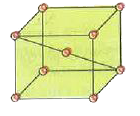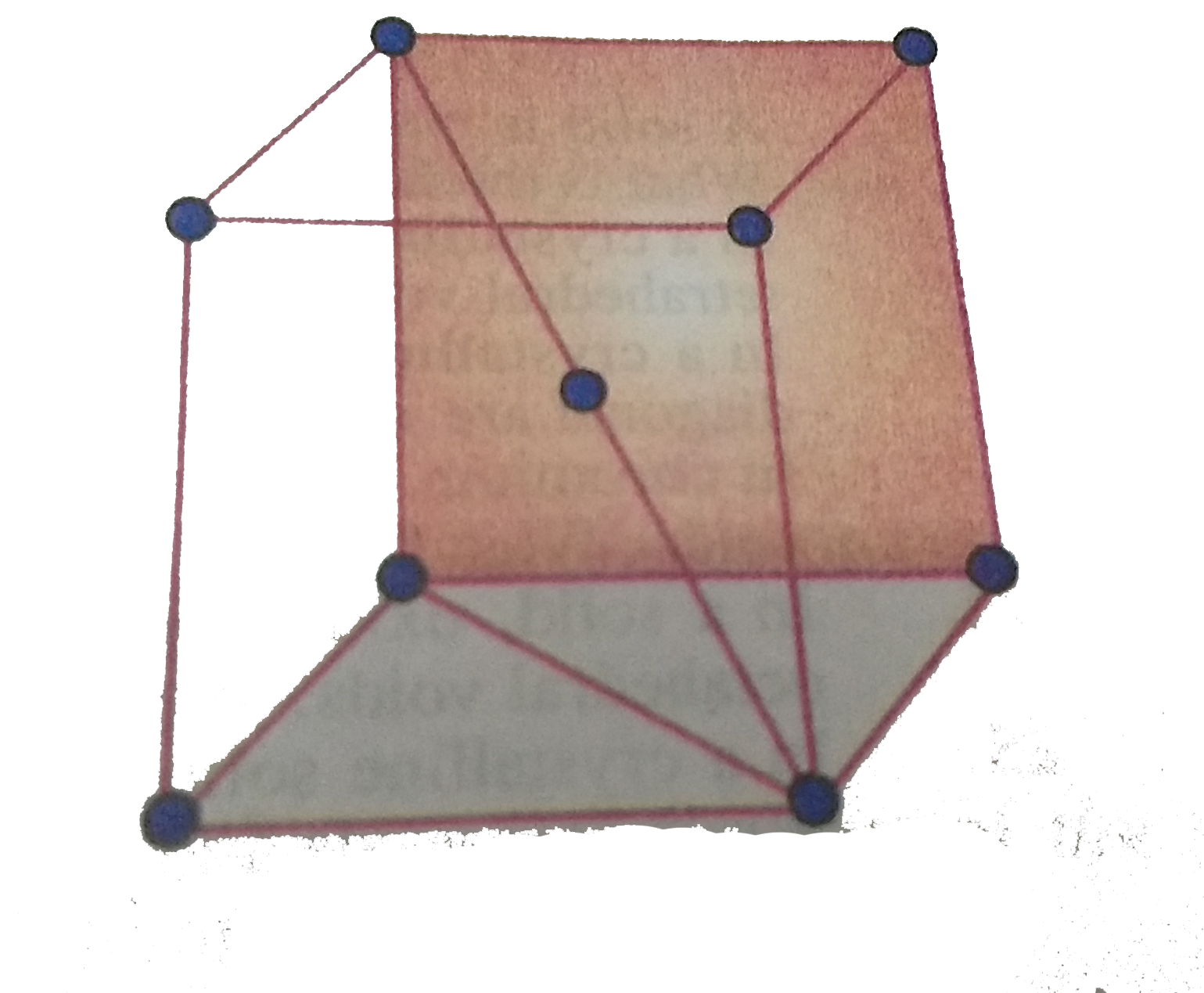Potassium crystallizes in body centered cubic lattice with a unit cell length a=5.2Å
(A) what is the distance betweenn nearest neighbourss?
(B) What is the distance between next nearest neighbour ?
(C) How many nearest neighbours does each K atom have ?
(D) How many next nearest neighbours does each K has ?
(E) What is calculated density of crystalline K
(a) The distance between nearest neighbours
=12× length of the body diagonal =12×√3a
=12×√3×5.20Å4.50Å.
(b) Distance between the next nearest neighbours
a=5.20Å
(c ) Number of K atoms (nearest neighbours) present at a distance of √3a/2 from the body centred atom = 8
(d) Number of K atoms (next nearest neighbours) present at distance of edge length = 6.
(e ) Density =n×MmNo×a3
where n = number of atoms in one unit cell of bcc = 2
Mm= Molar mass of K
=2×396.023×1023×(5.20×10−8)3=0.921gm/cm3.
Topper's Solved these Questions
- BOOK - FIITJEECHAPTER - SOLID STATEEXERCISE - SOLVED PROBLEMS (OBJECTIVE)25videos
SOLID STATE
- BOOK - FIITJEECHAPTER - SOLID STATEEXERCISE - SOLVED PROBLEMS (OBJECTIVE) REASONING TYPE QUESTIONS1videos
SOLID STATE
- BOOK - FIITJEECHAPTER - SOLID STATEEXERCISE - (SINGLE INTEGER ANSWER TYPE QUESTION)5videos
SOLID STATE
- BOOK - FIITJEECHAPTER - QUALITATIVE ANALYSIS EXERCISE - Single interger answer type3videos
QUALITATIVE ANALYSIS
- BOOK - FIITJEECHAPTER - STOICHIOMETRY AND BALANCING REDOX REACTION EXERCISE - SINGLE INTEGER ANSWER TYPE QUESTIONS5videos
STOICHIOMETRY AND BALANCING REDOX REACTION
Similar Questions
Potassium crystallizes in a body-centered cubic lattice with edge length, a = 5.2 Å
(a) What is the distance between nearest neighbours?
(b) What is the distance between next-nearest neighbours?
(c) How many nearest neighbours does each K atom have ?
(d) How many next-nearest neighbours does each K atom have ?
(e) What is the calculated density of crystalline potassium ?View SolutionAn element 'X' has bcc lattice as shown below :
The unit cell length, a is 306 pm.
(a) What is the distance between nearest neighbours?
(b) What is the distance between next nearest neighbours?
(c) How many nearest neighbours does each X atom have ?
(d) How many next nearest neighbours does each X have ?
 View Solution
View Solution
Knowledge Check
- Question 1 - Select One
A metal crystallize in a body centered cubic lattice (bcc) with the edge of the unit cell 5.2Å. The distance between the two nearest neighour is
A10.4ÅB4.5ÅC5.2ÅD9.0Å - Question 2 - Select One
Ar crystallizes in an F.C.C. lattice . If the unit cell length is 5.311A∘. find the distance between nearest neighbours.
A5.311A∘B3.75A∘C6.25A∘D7.33A∘ - Question 3 - Select One or More
What will be the distance between two nearest neighbours in primitive , fcc and bcc unit cell ?
AFor primitive , d=aBFor fcc, d=0.707 aCFor bcc, d=1.732 aDFor bcc , d=1.414 a
Potassium crystallises in a bcc lattice as shown in figure :
(a) What is the distance the nearest neighbours ?
(b) What is the distance between the next nearest neighbours ?
(c) How many nearest neighbours does each potassium atom have ?
(d) How many next nearest neighbours does each potassium atom have ?
 View Solution
View SolutionA metal crystallizes in a body centred cubic lattice (bcc) with the edge of the unit cell 5.2Å. The distance between the next nearest neighbour is:
View SolutionPlatinum crystallize in a face-centred cubic crystal with a unite cell length a. the distance between nearest neighbours is:
View SolutionPotassium crystallizes in a body centred cubic lattice. How many unit cells are present in 2g potassium ? (At. Mass of K=39)
View SolutionLithium crystallizes in a body centred cubic lattice. How many next-nearest neighbours does each Li have?
View Solution

